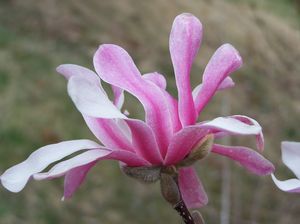View All Plants :: View All TREES
Magnolia x loebneri 'Leonard Messel'
Magnolia
Plant Type:
TREESMagnolia x loebneri ‘Leonard Messel’ – 'Leonard Messel' is another cross made in England between M. kobus and M. stellata 'Rosea'. It is a lovely pink and white form, essentially appearing a rich pink from the distance. Strap-shaped petals are purple-pink on the reverses and light pink to white on the interiors. And the flowers are sweetly fragrant. It makes a lovely dense multi-stemmed and or low-branched tree - rather upright and flame-shaped in youth, increasing it's girth and becoming more round-crowned at maturity. Leaves may pick up a good yellow to golden brown tone before dropping in autumn. I wasn't sold on this cultivar having seen it bloom in pots. But once it was planted in good moisture-retaining organic soil in sun it settled in and has turned into a head-turning tree when in bloom. 'Leonard Messel' is handsome year round. I've come to love this fine hybrid. Spring planting is advised in the northern end of its range. Cutting grown.
Height:
15-20 ftSpread:
15-20 ftColors:
Light Pink, Purple PinkCharacteristics and Attributes for Magnolia x loebneri 'Leonard Messel'
Season of Interest (Flowering)
- Spring
- Late Winter / Spring
Season of Interest (Foliage)
- Spring / Summer / Autumn
Interesting Bark
- Smooth
Nature Attraction
- Honey Bees & Native Bees
- Deer Resistant
Light
- Full Sun
Attributes
- Fragrant
- Shrub Border
- Specimen
- Hedge
- Alee
- Hedgerow
Growth Rate in the Garden
- Moderately Fast
Soil
- Fertile
- Organic
- Moist
Origins
- Garden Origin
Propagated By
- Cutting Grown
Genus Overview: Magnolia
Common Name: Magnolia
The Magnolias are one of the earliest known flowering plants to establish themselves on our beautiful planet. Much breeding continues and the cultivar list is expanding with some smaller sizes and new flower colors. Many are typical tree forms while some tend to be multi-stemmed – more like huge shrubs than single-stemmed trees. Most are spring blooming – some early, others later after danger of frost has passed in the north. A few of these will provide some recurrence of bloom during the summer. A handful bloom in summer. Many emit wonderful fragrance. The foliage is often large, bold and paddle-shaped, looking attractive in summer; a handful of species’ leaves are so large that they are reminiscent of banana foliage. Some seasons they develop gold to golden brown autumn color before the leaves drop. It’s hard for me to think of a landscape without one or more included in the mix. All prefer fertile deep loam with plenty of organic matter and moist soils – some are even content in relatively wet conditions. Magnolias should be sited in full to half sun exposures. All our selections are cutting grown, on their own wood – they are not grafted. Some are much easier to produce on their own wood than others; some are quite recalcitrant. In that, we may not always have certain plants available or available in great numbers. Spring planting is recommended for magnolias especially up north. Cutting grown.


